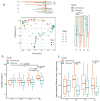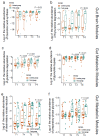Effects of a Formula with scGOS/lcFOS (9:1) and Glycomacropeptide (GMP) Supplementation on the Gut Microbiota of Very Preterm Infants
- PMID: 35565868
- PMCID: PMC9102166
- DOI: 10.3390/nu14091901
Effects of a Formula with scGOS/lcFOS (9:1) and Glycomacropeptide (GMP) Supplementation on the Gut Microbiota of Very Preterm Infants
Abstract
Microbial colonization of very preterm (VPT) infants is detrimentally affected by the complex interplay of physiological, dietary, medical, and environmental factors. The aim of this study was to evaluate the effects of an infant formula containing the specific prebiotic mixture of scGOS/lcFOS (9:1) and glycomacropeptide (GMP) on the composition and function of VPT infants' gut microbiota. Metagenomic analysis was performed on the gut microbiota of VPT infants sampled at four time points: 24 h before the trial and 7, 14, and 28 days after the trial. Functional profiling was aggregated into gut and brain modules (GBMs) and gut metabolic modules (GMMs) based on the Kyoto Encyclopedia of Genes and Genomes (KEGG) pathways. Enterococcus faecium, Escherichia coli, Klebsiella aerogenes, and Klebsiella pneumoniae were dominant species in both the test group and the control group. After the 4-week intervention, the abundance of Bifidobacterium in the test group was significantly increased. We found two GBMs (quinolinic acid synthesis and kynurenine degradation) and four GMMs (glutamine degradation, glyoxylate bypass, dissimilatory nitrate reduction, and preparatory phase of glycolysis) were significantly enriched in the test group, respectively. The results of this study suggested that formula enriched with scGOS/lcFOS (9:1) and GPM is beneficial to the intestinal microecology of VPT infants.
Keywords: glycomacropeptide; metagenomics; prebiotics; preterm.
Conflict of interest statement
The authors declare no conflict of interest. The funders had no role in the design of the study; in the collection, analyses, or interpretation of data; in the writing of the manuscript, or in the decision to publish the results.
Figures




Similar articles
-
Fermented infant formula (with Bifidobacterium breve C50 and Streptococcus thermophilus O65) with prebiotic oligosaccharides is safe and modulates the gut microbiota towards a microbiota closer to that of breastfed infants.Clin Nutr. 2021 Mar;40(3):778-787. doi: 10.1016/j.clnu.2020.07.024. Epub 2020 Jul 23. Clin Nutr. 2021. PMID: 32893049 Clinical Trial.
-
Supplementation of diet with non-digestible oligosaccharides alters the intestinal microbiota, but not arthritis development, in IL-1 receptor antagonist deficient mice.PLoS One. 2019 Jul 8;14(7):e0219366. doi: 10.1371/journal.pone.0219366. eCollection 2019. PLoS One. 2019. PMID: 31283798 Free PMC article.
-
The effect of enteral supplementation of a prebiotic mixture of non-human milk galacto-, fructo- and acidic oligosaccharides on intestinal permeability in preterm infants.Br J Nutr. 2011 Jan;105(2):268-74. doi: 10.1017/S0007114510003405. Epub 2010 Sep 24. Br J Nutr. 2011. PMID: 20863418 Clinical Trial.
-
Stool characteristics of infants receiving short-chain galacto-oligosaccharides and long-chain fructo-oligosaccharides: a review.World J Gastroenterol. 2014 Oct 7;20(37):13446-52. doi: 10.3748/wjg.v20.i37.13446. World J Gastroenterol. 2014. PMID: 25309075 Free PMC article. Review.
-
Human Milk Oligosaccharides to Prevent Gut Dysfunction and Necrotizing Enterocolitis in Preterm Neonates.Nutrients. 2018 Oct 8;10(10):1461. doi: 10.3390/nu10101461. Nutrients. 2018. PMID: 30297668 Free PMC article. Review.
Cited by
-
The Role of Bovine Kappa-Casein Glycomacropeptide in Modulating the Microbiome and Inflammatory Responses of Irritable Bowel Syndrome.Nutrients. 2023 Sep 15;15(18):3991. doi: 10.3390/nu15183991. Nutrients. 2023. PMID: 37764775 Free PMC article. Review.
-
Linking human milk oligosaccharide metabolism and early life gut microbiota: bifidobacteria and beyond.Microbiol Mol Biol Rev. 2024 Mar 27;88(1):e0009423. doi: 10.1128/mmbr.00094-23. Epub 2024 Jan 11. Microbiol Mol Biol Rev. 2024. PMID: 38206006 Free PMC article. Review.
-
Milk Bioactive Compounds and Gut Microbiota Modulation: The Role of Whey Proteins and Milk Oligosaccharides.Foods. 2024 Mar 16;13(6):907. doi: 10.3390/foods13060907. Foods. 2024. PMID: 38540897 Free PMC article. Review.
-
Microbiome-targeting therapies in the neonatal intensive care unit: safety and efficacy.Gut Microbes. 2023 Jan-Dec;15(1):2221758. doi: 10.1080/19490976.2023.2221758. Gut Microbes. 2023. PMID: 37358104 Free PMC article. Review.
References
MeSH terms
Substances
Grants and funding
LinkOut - more resources
Full Text Sources

